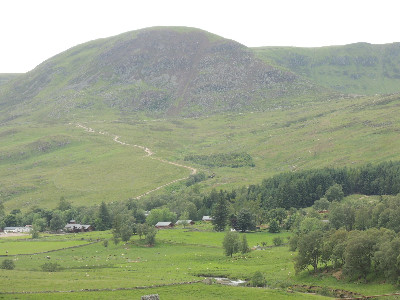Wednesday 11th March 2020, 4:11pm

Mountaineering Scotland has welcomed a decision which means a landowner will have to remove a controversial vehicle track in Glen Clova, in the Cairngorms National Park.
Reinstatement of the land must be completed within one year.
On Wednesday a Scottish Government reporter dismissed the landowner’s appeal against an earlier order demanding the removal of the vehicle track.
The decision ends a long-running battle over the 1.5km track, which is visible for miles around and features spoil mounds up to 10 metres wide.
The landowner had launched an appeal in December 2019 against Cairngorms National Park Authority’s enforcement notice ordering him to remove the vehicle track, as it appears to be used to support field sports.
But today Allison Coard, a reporter appointed by Scottish Ministers, dismissed the appeal and ordered the land to be restored “so far as is reasonably practicable” within one year.
Stuart Younie, Chief Executive Officer of Mountaineering Scotland, said: “We would like to congratulate the team at Cairngorms National Park for their work in winning this appeal in Glen Clova, which is a popular destination for climbers, walkers and visitors to the area. The widespread expansion and visual impact of unregulated vehicle tracks in the Scottish uplands is an issue which continues to be of great concern to many of our members.
“As we wait for the Scottish Government pay due attention to this problem and introduce much stronger regulations than currently exist, we hope this decision sends a clear message to those who feel they can bypass the existing planning process and damage the landscape in this way.“
Scottish Environment LINK Hilltracks Group, which continues to campaign for stronger public oversight of upland vehicle tracks, commended the reporter and the national park authority for their decisive action.
Helen Todd, who is Ramblers Scotland’s policy manager and co-convener of the LINK Hilltracks group, said: “This is a landmark result, and sadly one of very few examples of an authority feeling able to commit enough time and money to retrospectively tackle unauthorised tracks.
“This ugly track is scarring the landscape in this historic, protected glen – and we look forward to seeing the hillside restored within the coming year.
“All Scottish landowners should take note of today’s decision, and the expensive restoration job that the landowner will now need to carry out.”
Beryl Leatherland, of Scottish Wild Land Group and co-convener of the LINK Hilltracks group said: “The case highlights the urgent need for the Scottish Government to introduce stronger controls over vehicle tracks in our hills – to boost local democracy, improve construction standards and protect precious environments from further damage.”
The Scottish Government has made hilltracks one of the top priorities in its forthcoming review of ‘Permitted Development Rights’, which governs which types of developments can bypass the full planning permission process.
Currently, landowners simply need to tell authorities before building tracks which are said to support ‘agriculture or forestry’ – and full planning permission is generally not required. Campaigners believe these tracks are often created to support shooting activities and therefore should be subject to a planning application.
Research published in 2018 by the Scottish Environment LINK Hilltracks group found that vehicle tracks continue to expand further into Scotland’s mountain landscapes, and that weak planning processes can lead to them being badly-sited and designed. Some tracks have even been built over the top of narrow, low-impact trails and historical routes, with little chance for the public to comment in advance.
You can view the full appeal decision and history here.